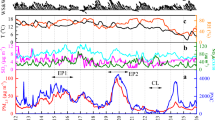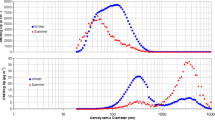Abstract
Evolution of submicron particles in terms of particle number concentration and mobility-equivalent diameter was measured during Diwali festival–specific intensive pyrotechnic displays in Varanasi over central Indo-Gangetic Plain (IGP). A scanning mobility particle sizer coupled with an optical particle sizer was used to fit in an overlapping size range, and particle number concentration was analyzed to have an insight into the new particle formation and subsequent evolution of particles from nucleation to accumulation mode. Further, variation in black carbon (BC) concentration and aerosol ionic composition was measured simultaneously. Frequent fluctuation in particle number concentration in and around Diwali festival was evidenced, primarily influenced by local emission sources and meteorology, with three distinct peaks in number concentrations (dN/dlogDp, 3.1–4.5 × 104 cm3) coinciding well with peak firework emission period (18:00–23:00 h). Submicron particle size distribution revealed a single peak covering a size range of 80–130 nm, and for all instances, number concentration maximum coincided with geometric mean minimum, indicating the emission primarily in the ultrafine range (< 0.1 μm). Interestingly, during peak firework emissions, besides rise in accumulation mode, an event of new particle formation was identified with increase in nucleation and small Aitken mode, before being dispersed to background aerosols. On an integral scale, a clear distinction was noted between a normal and an episodic event, with a definite shift in the formation of ultrafine particles compared with the accumulation mode. The BC diurnal profile was typical, with a prominent nocturnal peak (12.0 ± 3.9 μg m-3) corresponding to a decrease in the boundary layer height. A slight variation in maximum BC concentration (16.8 μg m-3) was noted in the night of the event coinciding well with firework emissions. An increase in some specific ionic species was also noted in combination with an increase in the overall cation to anion ratio, which was explained in terms of heterogeneous transformation of NOx and catalytic conversion of SO2.

Time-resolved evolution of particle size distribution during normal and episodic events.







Similar content being viewed by others
Data availability
The VIIRS land surface reflectance is available at NASA’s EOSDIS Worldview.
References
Banerjee, T., Murari, V., Kumar, M., & Raju, M. P. (2015). Source apportionment of airborne particulates through receptor modeling: Indian scenario. Atmospheric Research, 164, 167–187.
Becker, J. M., Iskandrian, S., & Conkling, J. (2000). Fatal and near-fatal asthma in children exposed to fireworks. Annals of Allergy, Asthma & Immunology, 85, 512–513.
Burnett, R., Chen, H., Szyszkowicz M et al. (2018). Global estimates of mortality associated with long-term exposure to outdoor fine particulate matter. Proc Natl Acad Sci USA, 115, 9592–9597.
Burney, J., & Ramanathan, V. (2014). Recent climate and air pollution impacts on Indian agriculture. PNAS, 11, 16319–16324.
Cheng, L., Peake, E., & Davis, A. (1987). The rate of SO2 to sulfate particle formation in an air parcel from an oil sands extraction plant plume. JAPCA, 37, 163–167.
Dal Maso, M., Kulmala, M., Riipinen, I., Wagner, R., Hussein, T., Aalto, P. P., & Lehtinen, K. E. (2005). Formation and growth of fresh atmospheric aerosols: eight years of aerosol size distribution data from SMEAR II, Hyytiala, Finland. Boreal Environment Research, 10, 323–336.
Deka, P., & Hoque, R. R. (2014). Diwali fireworks: early signs of impact on PM10 properties of rural Brahmaputra valley. Aerosol and Air Quality Research, 14, 1752–1762.
Devara, P. C., Vijayakumar, K., Safai, P. D., Made, P. R., & Rao, P. S. (2015). Celebration-induced air quality over a tropical urban station, Pune, India. Atmospheric Pollution Research, 6, 511–520.
Gettelman, A., Morrison, H., Terai, C. R., & Wood, R. (2013). Microphysical process rates and global aerosol–cloud interactions. Atmospheric Chemistry and Physics, 13, 9855–9867.
Goel, A., & Kumar, P. (2015). Characterisation of nanoparticle emissions and exposure at traffic intersections through fast–response mobile and sequential measurements. Atmospheric Environment, 107, 374–390.
Gong, X., Zhang, C., Chen, H., Nizkorodov, S. A., Chen, J., & Yang, X. (2016). Size distribution and mixing state of black carbon particles during a heavy air pollution episode in Shanghai. Atmospheric Chemistry and Physics, 16, 5399–5411.
Hansen, A. D. A., Rosen, H., & Novakov, T. (1984). The aethalometer—an instrument for the real-time measurement of optical absorption by aerosol particles. The Science of the Total Environment, 36, 191–196.
Jing, H., Li, Y. F., Zhao, J., Li, B., Sun, J., Chen, R., & Chen, C. (2014). Wide-range particle characterization and elemental concentration in Beijing aerosol during the 2013 Spring Festival. Environmental Pollution, 192, 204–211.
Joshi, M., Khan, A., Anand, S., & Sapra, B. K. (2016). Size evolution of ultrafine particles: Differential signatures of normal and episodic events. Environmental Pollution, 208, 354–360.
Kumar, M., Singh, R. S., and Banerjee, T. (2015). Associating airborne particulates and human health: exploring possibilities: comment on: Kim, Ki-Hyun, Kabir, E. and Kabir, S. 2015. A review on the human health impact of airborne particulate matter. Environment International 74 (2015) 136-143. Environment international, 84, 201.
Kumar, M., Singh, R. K., Murari, V., Singh, A. K., Singh, R. S., & Banerjee, T. (2016). Fireworks induced particle pollution: a spatio-temporal analysis. Atmospheric Research, 180, 78–91.
Kumar, M., Raju, M. P., Singh, R. K., Singh, A. K., Singh, R. S., & Banerjee, T. (2017a). Wintertime characteristics of aerosols over middle Indo-Gangetic Plain: vertical profile, transport and radiative forcing. Atmospheric Research, 183, 268–282.
Kumar, M., Raju, M. P., Singh, R. S., & Banerjee, T. (2017b). Impact of drought and normal monsoon scenarios on aerosol induced radiative forcing and atmospheric heating in Varanasi over middle Indo-Gangetic Plain. Journal of Aerosol Science, 113, 95–107.
Lelieveld, J., Evans, J. S., Fnais, M., Giannadaki, D., & Pozzer, A. (2015). The contribution of outdoor air pollution sources to premature mortality on a global scale. Nature, 525, 367–371.
Lin, C. C., Huang, K. L., Chen, H. L., Tsai, J. H., Chiu, Y. P., Lee, J. T., & Chen, S. J. (2014). Influences of beehive firework displays on ambient fine particles during the Lantern Festival in the YanShuei area of southern Taiwan. Aerosol and Air Quality Research, 14(7), 1998–2009.
Liu, D. Y., Rutherford, D., Kinsey, M., & Prather, K. A. (1997). Real-time monitoring of pyrotechnically derived aerosol particles in the troposphere. Analytical Chemistry, 69, 1808–1814.
Mhawish, A., Banerjee, T., Broday, D. M., Misra, A., & Tripathi, S. N. (2017). Evaluation of MODIS Collection 6 aerosol retrieval algorithms over Indo-Gangetic Plain: implications of aerosols types and mass loading. Remote Sensing of Environment, 201, 297–313.
Mhawish, A., Kumar, M., Mishra, A.K., Srivastava, P.K., Banerjee, T. (2018). Remote sensing of aerosols from space: retrieval of properties and applications. In. Remote Sensing of Aerosols, Clouds, and Precipitation. Elsevier Inc, 1-38. https://doi.org/10.1016/B978-0-12-810437-8.00003-7.
Moreno, T., Querol, X., Alastuey, A., Minguillón, M. C., Pey, J., Rodriguez, S., & Gibbons, W. (2007). Recreational atmospheric pollution episodes: inhalable metalliferous particles from firework displays. Atmospheric Environment, 41, 913–922.
Murari, V., Kumar, M., Barman, S. C., & Banerjee, T. (2015). Temporal variability of MODIS aerosol optical depth and chemical characterization of airborne particulates in Varanasi, India. Environmental Science and Pollution Research, 22, 1329–1343.
Murari, V., Kumar, M., Singh, N., Singh, R. S., & Banerjee, T. (2016). Particulate morphology and elemental characteristics: variability at middle Indo-Gangetic Plain. Journal of Atmospheric Chemistry, 73, 165–179.
Murari, V., Kumar, M., Mhawish, A., Barman, S. C., & Banerjee, T. (2017). Airborne particulate in Varanasi over middle Indo-Gangetic Plain: variation in particulate types and meteorological influences. Environmental Monitoring and Assessment, 189, 157–171.
Perrino, C., Tiwari, S., Catrambone, M., Dalla Torre, S., Rantica, E., & Canepari, S. (2011). Chemical characterization of atmospheric PM in Delhi, India, during different periods of the year including Diwali festival. Atmospheric Pollution Research, 2, 418–427.
Ramanathan, V. C. P. J., Crutzen, P. J., Kiehl, J. T., & Rosenfeld, D. (2001). Aerosols, climate, and the hydrological cycle. Science, 294, 2119–2124.
Retama, A., Neria-Hernández, A., Jaimes-Palomera, M., Rivera-Hernández, O., Sánchez-Rodríguez, M., López-Medina, A., & Velasco, E. (2019). Fireworks: a major source of inorganic and organic aerosols during Christmas and New Year in Mexico city. Atmospheric Environment: X, 2, 100013.
Sarkar, S., Khillare, P. S., Jyethi, D. S., Hasan, A., & Parween, M. (2010). Chemical speciation of respirable suspended particulate matter during a major firework festival in India. Journal of Hazardous Materials, 184, 321–330.
Seidel, D. J., & Birnbaum, A. N. (2015). Effects of Independence Day fireworks on atmospheric concentrations of fine particulate matter in the United States. Atmospheric Environment, 115, 192–198.
Sen, A., Abdelmaksoud, A. S., Ahammed, Y. N., Banerjee, T., Bhat, M. A., Chatterjee, A., & Gadi, R. (2017). Variations in particulate matter over Indo-Gangetic Plains and Indo-Himalayan Range during four field campaigns in winter monsoon and summer monsoon: role of pollution pathways. Atmospheric Environment, 154, 200–224.
Sharma, S. K., Kumar, M., Rohtash, Gupta, N. C., Saraswati, Saxena, M., & Mandal, T. K. (2014). Characteristics of ambient ammonia over Delhi, India. Meteorology and Atmospheric Physics, 124, 67–82.
Singh, R. P., Dey, S., & Holben, B. (2003). Aerosol behaviour in Kanpur during Diwali festival. Current Science, 84, 1302–1304.
Singh, N., Mhawish, A., Deboudt, K., Singh, R. S., & Banerjee, T. (2017). Organic aerosols over Indo-Gangetic Plain: Sources, distributions and climatic implications. Atmospheric Environment, 157, 59–74.
Thakur, B., Chakraborty, S., Debsarkar, A., Chakrabarty, S., & Srivastava, R. C. (2010). Air pollution from fireworks during festival of lights (Deepawali) in Howrah, India-a case study. Atmosfera, 23, 347–365.
Tritscher, T., Koched, A., Han, H. S., Filimundi, E., Johnson, T., Elzey, S., & Bischof, O. F. (2015). Multi-instrument manager tool for data acquisition and merging of optical and electrical mobility size distributions. In Journal of Physics: Conference Series (Vol. 617, No. 1, p. 012013). IOP Publishing.
Vecchi, R., Bernardoni, V., Cricchio, D., D’Alessandro, A., Fermo, P., Lucarelli, F., & Valli, G. (2008). The impact of fireworks on airborne particles. Atmospheric Environment, 42, 1121–1132.
Virkkula, A., Mäkelä, T., Hillamo, R., Yli-Tuomi, T., Hirsikko, A., Hämeri, K., & Koponen, I. K. (2007). A simple procedure for correcting loading effects of aethalometer data. Journal of the Air & Waste Management Association, 57, 1214–1222.
Wang, Y., Zhuang, G., Xu, C., & An, Z. (2007). The air pollution caused by the burning of fireworks during the lantern festival in Beijing. Atmospheric Environment, 41, 417–431.
Wen, L., & Chen, J. (2013). Severe aerosol pollution derived from fireworks: a case in Jinan, China. JSM Environmental Science & Ecology, 1, 1004.
Yamada, M., Takaya, M., & Ogura, I. (2015). Performance evaluation of newly developed portable aerosol sizers used for nanomaterial aerosol measurements. Industrial Health, 2014–0243.
Zhang, M., Wang, X., Chen, J., Cheng, T., Wang, T., Yang, X., & Chen, C. (2010). Physical characterization of aerosol particles during the Chinese New Year’s firework events. Atmospheric Environment, 44, 5191–5198.
Zhao, S., Yu, Y., Yin, D., & He, J. (2017). Effective density of submicron aerosol particles in a typical valley city, western China. Atmospheric Pollution Research, 17, 1–13.
Funding
This work was financially supported by the Bhabha Atomic Research Centre, Mumbai (No. 2013/36/67-BRNS/0577). Black carbon was monitored under Aerosol Radiative Forcing over India (ARFI) scheme (P-32-13) financed by Indian Space Research Organization, Thiruvananthapuram. MK acknowledges the Council for Scientific and Industrial Research (CSIR) for Senior Research Fellowship.
Author information
Authors and Affiliations
Corresponding author
Ethics declarations
Conflict of interest
The authors declare that they have no conflict of interest.
Additional information
Publisher’s note
Springer Nature remains neutral with regard to jurisdictional claims in published maps and institutional affiliations.
Electronic supplementary material
ESM 1
(DOCX 44 kb)
Rights and permissions
About this article
Cite this article
Yadav, S.K., Kumar, M., Sharma, Y. et al. Temporal evolution of submicron particles during extreme fireworks. Environ Monit Assess 191, 576 (2019). https://doi.org/10.1007/s10661-019-7735-2
Received:
Accepted:
Published:
DOI: https://doi.org/10.1007/s10661-019-7735-2




